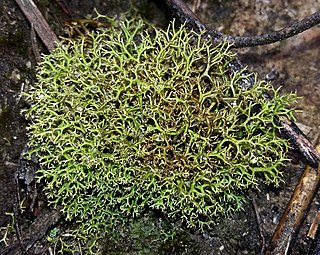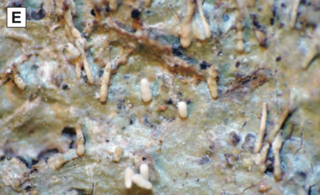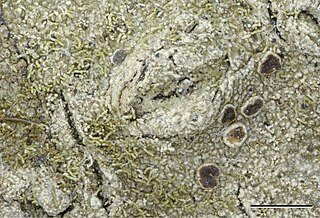Biatorellaceae is a family of lichen-forming fungi in the subclass Lecanoromycetidae. The family is monotypic, and contains the single genus Biatorella, which contains eight species.

The Graphidaceae are a family of lichen-forming fungi in the order Graphidales. The family contains nearly a hundred genera and more than 2000 species. Although the family has a cosmopolitan distribution, most Graphidaceae species occur in tropical regions, and typically grow on bark.

Cladia is a genus of lichen-forming fungi in the family Cladoniaceae. Cladia species have a crustose or squamulose (scaly) primary thallus and a fruticose, secondary thallus, often referred to as pseudopodetium. The type species of the genus, Cladia aggregata, is widely distributed, occurring in South America, South Africa, Australasia and South-East Asia to southern Japan and India. Most of the other species are found in the Southern Hemisphere.

Acanthotrema is a genus of lichens in the family Graphidaceae. The genus was circumscribed by German lichenologist Andreas Frisch in 2006, with Acanthotrema brasilianum assigned as the type species. Acanthotrema species are commonly found in rainforests ranging from lowland to montane environments.

Thelotrema is a genus of lichen-forming fungi in the family Graphidaceae, the family to which all taxa in the former Thelotremataceae now belong.

Anisomeridium is a genus of lichens in the family Monoblastiaceae. The type species was originally named Arthopyrenia xylogena by Swiss botanist Johannes Müller Argoviensis in 1883; in 1928, Maurice Choisy defined the genus Anisomeridium, designating A. xylogena the type species.

The Trypetheliaceae are a family of mainly lichen-forming fungi in the order Trypetheliales. The family consists almost exclusively of corticolous (bark-dwelling), crustose lichens with an almost strictly tropical distribution.

Mycoblastus is a genus of crustose lichens in the family Tephromelataceae. Members of the genus are commonly called blood lichens.

Neoprotoparmelia is a genus of crustose lichens that was created in 2018. It contains 24 tropical and subtropical species that mostly grow on bark. Neoprotoparmelia is in the subfamily Protoparmelioideae of the family Parmeliaceae, along with the morphologically similar genera Protoparmelia and Maronina.

Coenogonium is a genus of filamentous lichens in the monotypic family Coenogoniaceae. It has about 90 species. Most species are leaf-dwelling or grow on bark, although a few are known to grow on rocks under certain conditions, and some are restricted to growth on termite nests. The genus was circumscribed in 1820 by German naturalist Christian Gottfried Ehrenberg.

Solenopsora is a genus of lichen-forming fungi in the family Catillariaceae. It has 15 species, with a mostly Northern Hemisphere distribution.

Schaereria is a genus of lichen-forming fungi. It is the sole genus in the family Schaereriaceae, which itself is the only family in the Schaereriales, an order in the subclass Ostropomycetidae of the class Lecanoromycetes. Most Schaereria species are crustose lichens that live on rocks. Schaereria was first proposed by Gustav Wilhelm Körber in 1855 and was later taken up by other lichenologists despite periods of disuse.
Schizotrema is a genus of lichen-forming fungi in the family Graphidaceae. The genus was circumscribed in 2009 by Armin Mangold and H. Thorsten Lumbsch.
Megalospora occidentalis is a species of corticolous (bark-dwelling), crustose lichen in the family Megalosporaceae. Found in Australia, it was formally described as a new species in 1994 by lichenologist Gintaras Kantvilas. The type specimen was collected along the Vasse Highway in Beedelup National Park at an altitude of 100 m (330 ft); here, in a karri-dominated wet sclerophyll forest, it was found growing on Trymalium floribundum. The lichen has a thin, pale grey to glaucous-grey thallus that usually has scattered soredia. Its ascospores are oblong to ellipsoid in shape, measuring 50–90 by 20–30 μm. They are muriform, meaning they are divided into many internal cells, up to about 22 by 10. The species contains the lichen products pannarin and zeorin. The author named it occidentalis because, at the time of writing, it was the only Western Australian species known in genus Megalospora.
Pseudochapsa is a genus of lichen-forming fungi in the family Graphidaceae. It has 19 species. It was circumscribed in 2012 by Sittiporn Parnmen, Robert Lücking, and Helge Thorsten Lumbsch, with Pseudochapsa dilatata as the type species. Pseudochapsa differs from Chapsa it that its excipulum is typically brown. Additionally, its ascospores are mostly discoseptate and amyloid. The generic name combines the Greek pseudo ("false") with the genus name Chapsa.
Myriochapsa is a genus of corticolous (bark-dwelling), crustose lichens in the subfamily Graphidoidae of the family Graphidaceae. It has three species. The genus was circumscribed in 2013 by Marcela Cáceres, Robert Lücking, and H. Thorsten Lumbsch, with the Brazilian Myriochapsa psoromica assigned as the type species. The generic name combines Myriotrema and Chapsa, referring to the two Graphidaceae genera that it resembles. The main distinguishing characteristics of the new genus are its densely corticate thallus, and the presence of the lichen product psoromic acid. Additionally, its apothecia have wider pores, with differently textured margins. Although originally created as a monotypic genus, Harrie Sipman added two South American species in 2014.
Cameronia is a genus of crustose lichens in the monotypic family Cameroniaceae. It has two species. Both the genus and its two species were described as new to science in 2011 by Australian lichenologist Gintaras Kantvilas. Characteristics of the genus include its chlorococcalean photobiont partner, and perithecioid ascomata that are deeply immersed in the substrate. Microscopic features of Cameronia include the four-spored asci with an intensely hemiamyloid outer wall and non-amyloid, well-developed tholus, and hyaline, muriform ascospores. Both species are endemic to the Tasmanian Highlands.
Clandestinotrema is a genus of lichen-forming fungi in the family Graphidaceae. It has 17 species. They typically inhabit montane and cloud forest at higher elevations in the tropics.
Gintarasia is a genus of lichen-forming fungi in the family Graphidaceae. It has seven species, all of which are found in Australia. Gintarasia species are corticolous (bark-dwelling), crustose lichens with a thelotremoid form.
Megalospora austropacifica is a species of corticolous (bark-dwelling), crustose lichen in the family Megalosporaceae. It is found on the islands of Taveuni and Viti Levu in Fiji. It has a yellowish grey to whitish grey, glossy thallus that is thick and may appear slightly wrinkled or smooth, often with irregular cracks and small papillae containing conidiomata, but lacking isidia and soredia. Its apothecia are circular, up to 4.5 mm in diameter, with the disc evolving from concave to slightly convex and coloured from orange-brown to red-brown, surrounded by a thick, prominent margin.











